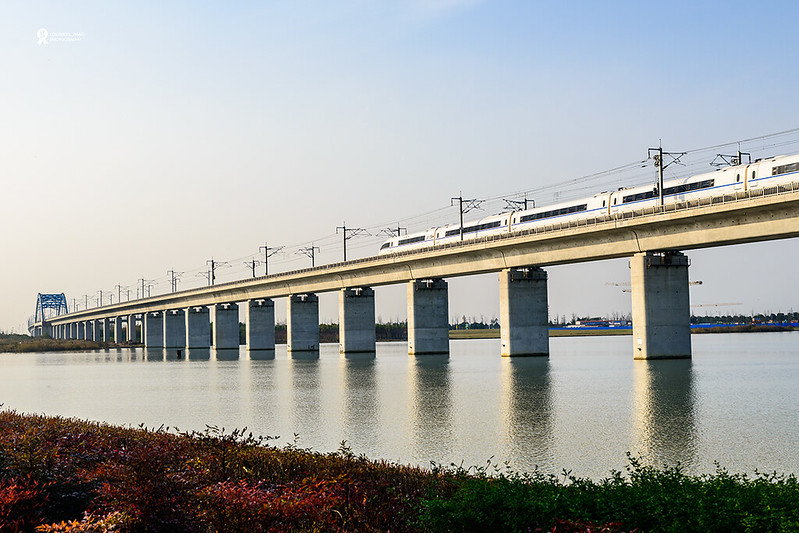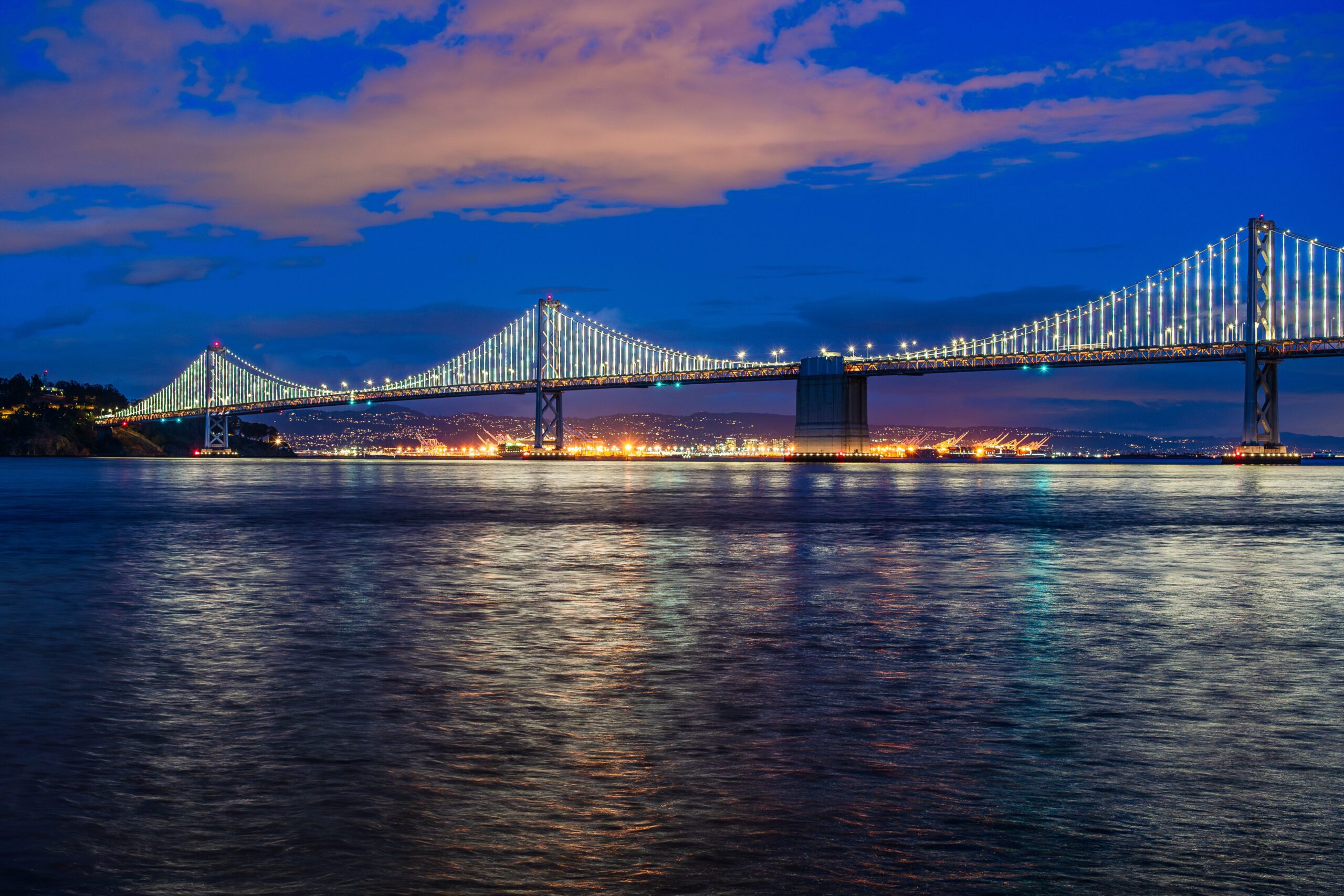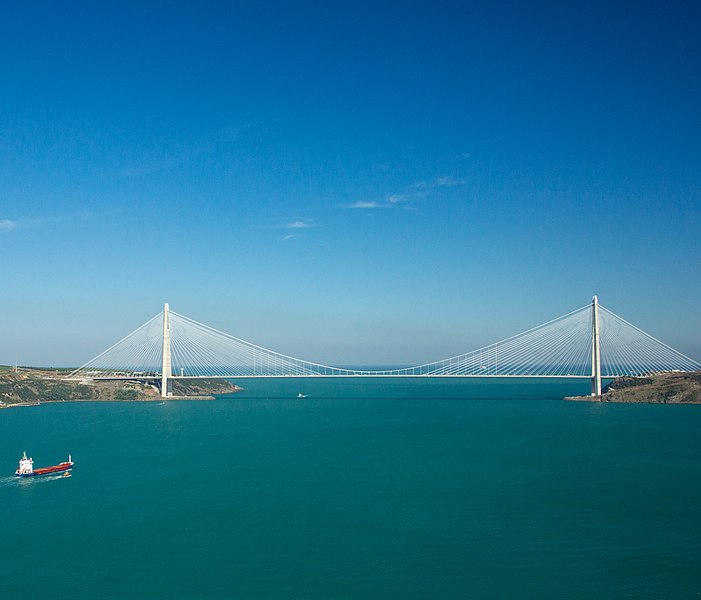Bridges are some of the most impressive feats of engineering, connecting distant places and making travel faster and easier. Some of the longest bridges in the world stretch across vast landscapes, including seas, rivers, and even mountains, and are essential for transportation and commerce. These massive structures not only serve as vital links between cities and countries but also showcase remarkable advancements in design, technology, and construction. In this article, we’ll take a closer look at the 17 longest bridges around the globe, exploring their unique features, their importance, and what makes them stand out in the world of modern infrastructure.
Danyang–Kunshan Grand Bridge (China)

The Danyang–Kunshan Grand Bridge spans an incredible 164.8 kilometers (102.4 miles) across eastern China, making it the longest bridge in the world. Completed in 2010, this colossal structure is part of the Beijing–Shanghai High-Speed Railway. It stretches across a variety of terrains, including water, roads, and agricultural areas, showcasing impressive engineering capabilities. The bridge required around 10,000 workers and four years to construct, with over 10,000 piers supporting its structure. Its design is a testament to China’s rapid infrastructure development, using advanced technologies like seismic resistance. It was built to withstand strong winds, earthquakes, and the environmental challenges of the region. The Danyang–Kunshan Grand Bridge connects several major cities and contributes to the high-speed rail system that revolutionized travel in China.
Changhua-Kaohsiung Viaduct (Taiwan)

Stretching 157.3 kilometers (97.8 miles), the Changhua-Kaohsiung Viaduct is a vital component of Taiwan’s high-speed rail system. Completed in 2007, it connects the northern city of Taipei to the southern city of Kaohsiung, cutting travel time drastically. The viaduct is notable for its elevated design, which allows trains to bypass busy urban areas. Constructed with over 3,000 piers, this bridge is designed to handle speeds of up to 300 km/h (186 mph), making it one of the fastest rail bridges in the world. The structure’s resilience to natural disasters, such as typhoons, is a key feature of its design. Its sleek, minimalistic design blends seamlessly into Taiwan’s diverse landscape, from mountains to flat plains. The Changhua-Kaohsiung Viaduct is a vital link for the island’s transportation network, enhancing both economic and cultural exchanges.
Tianjin Grand Bridge (China)

The Tianjin Grand Bridge, with a length of 113.7 kilometers (70.6 miles), is an impressive structure that spans across northern China. Opened in 2010, it was built to accommodate the high-speed trains traveling between Beijing and Shanghai. The bridge features a combination of viaducts and elevated sections, ensuring minimal disruption to the natural landscape below. At its peak, the bridge rises as high as 70 meters above the ground in some areas, providing a breathtaking view of the surrounding plains. The bridge supports a maximum speed of 300 km/h (186 mph), offering a fast and efficient way to travel across the region. Designed to withstand seismic forces, it is robust enough to handle both natural disasters and high-speed train operations. The Tianjin Grand Bridge represents a significant leap forward in China’s high-speed rail infrastructure.
Qingdao Haiwan Bridge (China)

The Qingdao Haiwan Bridge, spanning 41.58 kilometers (25.9 miles), is the longest sea bridge in the world. It connects the city of Qingdao to the Huangdao District in eastern China, cutting down travel time significantly for commuters. Completed in 2011, the bridge was built to withstand the harsh maritime environment, including strong waves and corrosive saltwater. Its unique design incorporates both suspension and cable-stayed elements, making it an engineering feat of its time. The bridge is made of reinforced concrete and steel, allowing it to support both road traffic and heavy cargo trucks. At its highest point, it stands over 60 meters above the water, providing ships with ample clearance. The Qingdao Haiwan Bridge has transformed travel along this stretch of the Yellow Sea and boosted the region’s economic growth.
Lake Pontchartrain Causeway (USA)

Spanning 38.6 kilometers (24 miles), the Lake Pontchartrain Causeway is the longest bridge over water in the United States. Opened in 1956, the causeway connects the city of New Orleans to the North Shore of Lake Pontchartrain. The bridge consists of two parallel spans, with the original span being the longest of the two. Its structure is simple yet highly effective, built to withstand the extreme weather conditions often experienced in the region. The Lake Pontchartrain Causeway holds the distinction of being the longest continuous bridge over water in the world for several decades. Despite the area’s vulnerability to hurricanes, the causeway has proven resilient, with frequent upgrades to its infrastructure. The causeway remains a key transportation link for the region, facilitating both daily commutes and long-distance travel.
Hangzhou Bay Bridge (China)

The Hangzhou Bay Bridge, located in eastern China, stretches 35.7 kilometers (22.2 miles) across the bay. Completed in 2008, it provides a vital connection between the cities of Shanghai and Ningbo. This bridge is particularly notable for its unique design, which incorporates a combination of viaducts and cable-stayed spans. Built to withstand strong winds, earthquakes, and corrosion from salty ocean air, the Hangzhou Bay Bridge is an engineering marvel. The bridge’s design minimizes environmental disruption by carefully navigating around wetlands and marine ecosystems. It also reduces travel time between the two cities by over an hour, greatly benefiting local economies. The Hangzhou Bay Bridge stands as an example of China’s rapidly developing infrastructure and commitment to innovation in transportation.
Xihoumen Bridge (China)

The Xihoumen Bridge, spanning 36 kilometers (22.4 miles) across the Zhoushan Archipelago, is the world’s longest suspension bridge. Opened in 2009, it connects the islands of Jintang and Cezi, facilitating easier transportation for both locals and visitors. The bridge was designed to endure the region’s unpredictable weather patterns, including typhoons, by incorporating advanced engineering techniques. Its main span is 1,650 meters (5,413 feet) long, making it one of the longest of its type. The bridge plays a significant role in the economic development of the Zhoushan Islands, allowing for faster movement of goods and people. It also serves as a key transportation link between several smaller islands, reducing reliance on ferries. The Xihoumen Bridge is a remarkable example of modern bridge design, blending functionality with aesthetics.
San Francisco-Oakland Bay Bridge (USA)

Spanning 7.18 kilometers (4.5 miles), the San Francisco-Oakland Bay Bridge is one of the most iconic bridges in the United States. Opened in 1936, the bridge connects the city of San Francisco to the East Bay Area, including Oakland. Its complex design includes two major spans, one of which is a suspension bridge, while the other is a viaduct. The Bay Bridge is notable for its central span, which is the longest of its type in the world, stretching over 2,300 meters (7,500 feet). The bridge underwent a major retrofit after the 1989 Loma Prieta earthquake, enhancing its seismic resilience. It continues to be a vital traffic artery, serving hundreds of thousands of commuters daily. The San Francisco-Oakland Bay Bridge is an enduring symbol of engineering excellence and urban connectivity.
Runyang Yangtze River Bridge (China)

The Runyang Yangtze River Bridge, stretching 35.6 kilometers (22.1 miles), is a significant feat of engineering in China. Completed in 2005, it connects the provinces of Jiangsu and Anhui, crossing the Yangtze River. The bridge is a multi-tiered structure, consisting of a suspension bridge, cable-stayed bridge, and viaducts. It serves as a crucial part of the road network, alleviating congestion on nearby ferries. Designed to withstand harsh weather conditions and seismic activity, the bridge features a robust, resilient structure. The Runyang Yangtze River Bridge was the longest cable-stayed bridge in the world at the time of its completion. Today, it stands as an enduring symbol of China’s rapid infrastructural development.
Yavuz Sultan Selim Bridge (Turkey)

At 59.5 kilometers (37 miles), the Yavuz Sultan Selim Bridge in Turkey is an engineering marvel that crosses the Bosphorus Strait. Opened in 2016, it is one of the most significant bridges in the country, designed to alleviate congestion on the heavily trafficked northern Bosphorus Bridge. The bridge is a part of the Istanbul’s third bridge project, designed to accommodate both road traffic and railway lines. Its design incorporates a cable-stayed structure with multiple lanes, allowing it to handle significant volumes of traffic daily. The Yavuz Sultan Selim Bridge is not only an essential transportation link but also a symbol of Turkey’s expanding infrastructure. With its striking architecture, it has become a modern landmark in Istanbul. The bridge’s strategic location connects the European and Asian sides of Istanbul more efficiently.
Huanghe (Yellow River) Bridge (China)

Measuring 48.2 kilometers (30 miles) in length, the Huanghe Bridge is one of the longest bridges over the Yellow River in China. Opened in 2012, it is a key transportation link in the region, providing a vital connection between Shandong and Henan provinces. The bridge is particularly significant for facilitating the movement of goods and passengers across a region that is often affected by seasonal flooding. Its structure features both viaducts and suspension sections, ensuring stability and safety even in extreme weather conditions. The Huanghe Bridge’s design incorporates cutting-edge engineering technologies to cope with the heavy traffic and the river’s unpredictable nature. It also plays a critical role in the economic development of central China by improving access to remote areas. Today, it serves as a crucial part of the country’s extensive network of bridges.
Tianjin Haihe River Bridge (China)

Spanning 33 kilometers (20.5 miles), the Tianjin Haihe River Bridge is a vital link in Tianjin’s urban transportation system. Opened in 2011, it crosses the Haihe River and connects several districts within the city. This bridge is designed to support both road traffic and pedestrian movement, with multiple lanes for vehicles. Its engineering design includes elevated sections that allow it to rise above the water, ensuring stability during floods. The bridge is equipped with features designed to endure the challenges of the local climate, which includes high winds and seasonal flooding. Its completion has significantly improved the efficiency of the city’s transport network. As part of Tianjin’s rapid modernization, the bridge is a key infrastructure element in connecting the city’s commercial and residential areas.
Hong Kong-Zhuhai-Macao Bridge (China)

The Hong Kong-Zhuhai-Macao Bridge is a remarkable 55 kilometers (34 miles) long, making it the longest sea-crossing bridge in the world. Opened in 2018, it connects the three major cities of Hong Kong, Zhuhai, and Macao, facilitating faster travel and trade between the regions. The bridge is a combination of a series of viaducts, undersea tunnels, and artificial islands. Built to withstand extreme weather conditions, including typhoons, it features advanced engineering, including a cable-stayed design and a submerged tunnel section. The bridge’s construction faced numerous challenges, including the need to preserve marine life and manage heavy shipping traffic. It is a symbol of economic integration, significantly reducing travel time from several hours to just 30 minutes. The Hong Kong-Zhuhai-Macao Bridge stands as a testament to innovative infrastructure development.
Great Belt Bridge (Denmark)

Connecting the islands of Zealand and Funen in Denmark, the Great Belt Bridge spans 18 kilometers (11.2 miles) across the Great Belt Strait. Completed in 1998, it is composed of a suspension bridge, an east bridge, and a viaduct, all of which are marvels of modern engineering. The main suspension bridge, with its two massive towers, rises 254 meters above the water, making it one of the tallest structures in Denmark. The Great Belt Bridge handles both road and rail traffic, significantly improving transportation links between Denmark’s eastern and western regions. Its construction required overcoming considerable challenges, including harsh weather conditions and deep waters. The bridge is also designed to withstand the area’s frequent storms and seismic activities. Serving as a key economic link, it facilitates trade, tourism, and the flow of goods and services across Denmark.
Forth Road Bridge (Scotland)

Spanning 2.5 kilometers (1.6 miles) across the Firth of Forth in Scotland, the Forth Road Bridge is a crucial crossing for both road and pedestrian traffic. Opened in 1964, it was, at the time, the longest suspension bridge in the world. The bridge is known for its distinctive blue color, and its sleek, modern design was a significant engineering achievement for its era. It features two main towers and a central span of 1,006 meters, which was groundbreaking at the time of its construction. The Forth Road Bridge is an iconic structure, providing vital connectivity between Edinburgh and Fife. It remains an essential transportation link, despite the opening of a newer bridge, the Queensferry Crossing, nearby in 2017. The Forth Road Bridge has played a major role in Scotland’s development and is considered a cultural landmark.
Viaduc de Millau (France)

The Viaduc de Millau, located in southern France, stretches 2.46 kilometers (1.5 miles) and is one of the most stunning bridges in the world. Opened in 2004, it crosses the Tarn River Valley and is renowned for its extraordinary height, with the bridge deck sitting 270 meters (890 feet) above the valley below, making it the tallest bridge in Europe. Designed by architect Norman Foster, the bridge has seven towering pillars, with the highest one reaching 343 meters (1,125 feet), taller than the Eiffel Tower. It is a cable-stayed bridge, allowing for a smooth, continuous road without the need for many support piers. The Viaduc de Millau was built to reduce traffic congestion and improve connectivity between Paris and the Mediterranean region. Its sleek, minimalist design blends harmoniously with the surrounding natural landscape. The Viaduc de Millau is not only a technical marvel but also a work of art that attracts tourists from around the world.
Akashi Kaikyō Bridge (Japan)

The Akashi Kaikyō Bridge, also known as the Pearl Bridge, spans 3.91 kilometers (2.43 miles) across the Akashi Strait, connecting the city of Kobe to Awaji Island in Japan. Completed in 1999, it holds the record for the world’s longest central span of 1,991 meters (6,532 feet), a feat that required innovative engineering. The bridge was constructed to withstand the frequent seismic activity in the region, including earthquakes and typhoons. Its main span is supported by two massive towers, each standing over 282 meters tall, and the bridge is designed to handle heavy traffic loads, including freight and passenger vehicles. Due to its location in a highly active tectonic zone, the Akashi Kaikyō Bridge incorporates advanced technologies to ensure its resilience against natural forces. It has become a symbol of Japan’s technological prowess, connecting the islands of Honshu and Shikoku. The bridge is not only a transportation link but also a vital part of Japan’s infrastructure, fostering economic and cultural exchange.
This article originally appeared on Rarest.org.
More From Rarest.Org
The world’s largest casinos are more than just places to gamble, they are destinations for entertainment, luxury, and unforgettable experiences. These sprawling venues cover immense spaces with gaming tables, slot machines, fine dining, and top-tier entertainment options. Read more.
The global economy is shaped by the powerhouse nations that dominate markets and drive international trade. Each country on this list holds a pivotal role, marked by their impressive GDP, large labor forces, and strategic partnerships. Read more.
The Olympic Games hold a deep, timeless tradition, showcasing sports that have been around for centuries. Many of the earliest events were born in ancient Greece, reflecting both skill and endurance. Read more.



